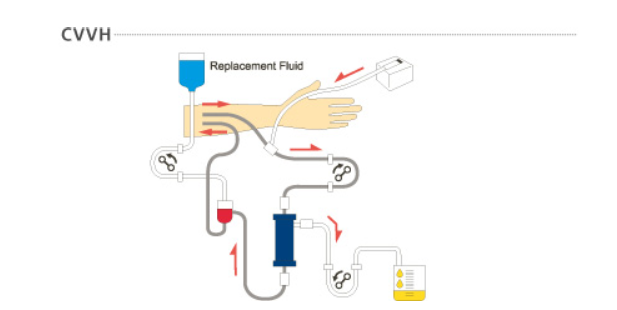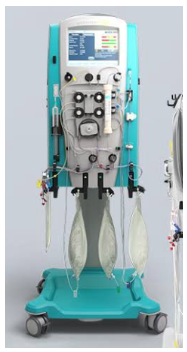Oleh: Thalia Kaylyn Averil
Continuous Veno-Venous Hemofiltration (CVVH) dilakukan untuk pengobatan jangka pendek gagal ginjal. Pada umumnya, pasien yang mengalami gagal ginjal akan dilakukan hemodialisis, tetapi CVVH mungkin diperlukan sebagai cadangan jika pasien memiliki kontraindikasi terhadap hemodialisis. Pasien dengan gagal ginjal akut yang tidak stabil juga dapat diobati untuk sementara dengan CVVH. CVVH biasanya digunakan sampai fungsi ginjal pasien kembali normal atau hemodialisis dapat dimulai.
Lalu, apa perbedaan antara hemodialisis dan Continuous Veno-Venous Hemofiltration (CVVH)?
| Hemodialisis | CVVH |
| Hemodialisis biasanya dilakukan selama beberapa jam dengan frekuensi kurang lebih tiga kali seminggu. | CVVH adalah terapi berkelanjutan yang dilakukan selama 24 jam. |
| Hemodialisis kurang efektif dalam pengeluaran cairan dan zat terlarut berlebih di dalam tubuh. | CVVH lebih efektif untuk mengeluarkan cairan dan zat terlarut berlebih dari tubuh daripada hemodialisis. |
| Hemodialisis tidak dapat dilakukan pada pasien dengan kondisi hemodinamik yang tidak stabil karena dapat menyebabkan ketidakstabilan hemodinamik. | CVVH menyebabkan lebih sedikit perubahan hemodinamik sehingga lebih ditoleransi oleh pasien yang hemodinamiknya tidak stabil. |
Kateter yang digunakan selama prosedur CVVH memiliki dua jalur yang berbeda. Kateter dialisis akan dimasukkan ke salah satu pembuluh darah balik utama tubuh, seperti vena femoralis, vena jugularis, atau vena subklavia karena CVVH membutuhkan akses vaskular yang memadai. Darah masuk ke dalam mesin CVVH setelah darah keluar dari kateter melalui pemompaan. Di dalam mesin, darah melewati membran semipermeabel sehingga air dan zat terlarut, seperti produk limbah, dapat dibuang. Namun, sel-sel darah dan molekul yang lebih besar ditahan sehingga tidak terbuang. Selanjutnya, cairan dan elektrolit akan digantikan dengan cairan pengganti berupa larutan dialisat sehingga dapat mengatur keseimbangan cairan dan memperbaiki ketidakseimbangan elektrolit. Pada akhirnya, darah pasien yang telah disaring akan dikembalikan ke dalam tubuh menggunakan kateter. Selama prosedur CVVH dilakukan, diperlukan antikoagulan untuk mencegah terjadinya pembekuan darah. Durasi CVVH bervariasi tergantung pada kondisi pasien dan respons pasien terhadap pengobatan. Prosedur CVVH biasanya dilakukan selama 24 jam sehari. Studi lain menunjukkan bahwa CVVH biasanya dilakukan sampai hemodialisis dapat dilakukan atau fungsi ginjal pasien kembali normal.

Gambar 1. Ilustrasi mekanisme kerja Continuous Veno-Venous Hemofiltration (CVVH).
CVVH dapat digunakan untuk pasien yang mengalami gagal ginjal akut, sepsis, syok septik, dan gagal organ multipel. Selain itu, CVVH juga bisa digunakan untuk pasien dengan hemodinamik yang tidak stabil, meliputi tekanan darah rendah, detak jantung yang terlalu cepat atau lambat, denyut nadi lemah atau tidak teraba, kulit terasa dingin, produksi urin berkurang, atau perubahan status mental. Namun, CVVH dikontraindikasikan pada pasien-pasien berikut:
- Pasien dengan akses pembuluh darah yang terbatas.
- Pasien yang memiliki kontraindikasi terhadap terapi antikoagulan karena antikoagulan akan digunakan selama prosedur CVVH. Contohnya adalah pasien dengan riwayat perdarahan intrakranial, pasien yang mengalami perdarahan aktif atau memiliki risiko perdarahan tinggi, pasien dengan koagulopati yang tidak terkontrol, pasien dengan trombositopenia berat, atau pasien yang baru menjalani bedah gastrointestinal.
Berikut adalah manfaat-manfaat dari CVVH untuk pasien dengan gagal ginjal akut:
- CVVH dapat membantu menjaga stabilitas hemodinamik sehingga cocok untuk pasien dengan kontraindikasi terhadap hemodialisis, seperti pasien dengan tekanan darah rendah.
- Penumpukkan cairan dalam jumlah besar di dalam tubuh biasanya terjadi pada pasien dengan gagal ginjal akut atau sepsis. Cairan yang berlebih dapat dibuang melalui ultrafiltrasi, yaitu proses mengeluarkan air dan molekul-molekul terlarut dari darah melalui membran semipermeabel tanpa mengeluarkan solut. Laju ultrafiltasi pada CVVH dapat dikontrol dan disesuaikan dengan kondisi pasien.
- Selain itu, CVVH juga dapat membantu mengeluarkan zat-zat sisa seperti urea, kreatinin, dan produk metabolisme lainnya yang menumpuk di dalam darah.
- CVVH mungkin memerlukan lebih sedikit antikoagulan dibandingkan continuous renal replacement therapy (CRRT) lainnya sehingga pasien yang mengalami perdarahan memiliki risiko lebih rendah.
- CVVH dapat digunakan sebagai alternatif untuk pasien-pasien yang memiliki kontraindikasi terhadap hemodialisis karena hemodinamik yang tidak stabil sampai hemodialisis dapat dilakukan atau fungsi ginjal pasien kembali normal. CVVH umumnya dilakukan pada pasien yang dirawat di unit perawatan intensif (ICU).
Rumah Sakit Abdi Waluyo telah dilengkapi dengan Continuous Veno-Venous Hemofiltration (CVVH) yang menawarkan layanan untuk pasien yang sedang mengalami berbagai macam kondisi, termasuk gagal ginjal akut, sepsis, syok septik, gagal organ multipel, dan kondisi hemodinamik yang tidak stabil.

Gambar 2. Mesin Continuous Veno-Venous Hemofiltration (CVVH) di Rumah Sakit Abdi Waluyo.
Referensi:
- Massachusetts General Hospital. Continuous Veno-Venous Hemofiltration (CVVH) program [Internet]. Boston: Massachusetts General Hospital; date of publication unknown [cited 2024 Jan 16]. Available from: https://www.massgeneral.org/medicine/nephrology/treatments-and-services/cvvh
- Tandukar S, Palevsky PM. Continuous Renal Replacement Therapy: Who, When, Why, and How. Chest [Internet]. 2019 Mar [cited 2024 Jan 16];155(3):626-638. Available from: https://www.ncbi.nlm.nih.gov/pmc/articles/PMC6435902/
- Saunders H, Rehan A, Sanghavi DK. Continuous Renal Replacement Therapy. [Updated 2023 May 8]. In: StatPearls [Internet]. Treasure Island (FL): StatPearls Publishing; 2023 Jan-. Available from: https://www.ncbi.nlm.nih.gov/books/NBK556028/
- Ronco C, Bellomo R, Kellum JA. Critical care nephrology. 2nd ed. San Francisco: Elsevier: 2008.
- Asahi Kasei Medical. Continuous Renal Replacement Therapy (CRRT) [Internet]. Tokyo: Asahi Kasei; date of publication unknown [cited 2023 Jan 16]. Available from: https://www.asahi-kasei.co.jp/medical/en/apheresis/product/crrt/about/cure.html
